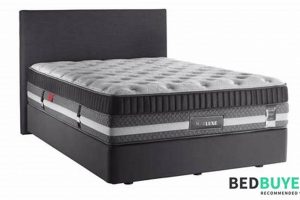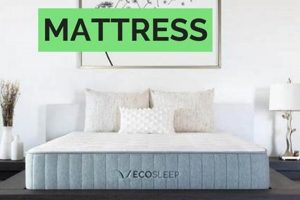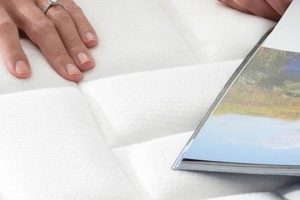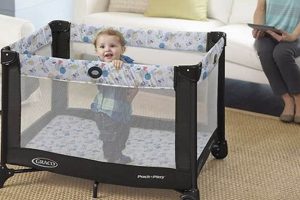A sleeping surface designed to maximize air circulation and minimize heat retention for infants can be categorized as a product promoting breathability. These mattresses typically feature materials and construction techniques that allow air to flow freely, mitigating the risk of overheating and potentially reducing the incidence of suffocation or Sudden Infant Death Syndrome (SIDS) by allowing carbon dioxide to dissipate quickly. Examples include mattresses made with open-cell foam, breathable mesh covers, or those incorporating internal ventilation systems.
The importance of such a product stems from the delicate thermoregulation abilities of infants. Newborns and young babies are less efficient at regulating their body temperature, making them more susceptible to overheating, which has been linked to SIDS. The utilization of a sleeping surface that allows for optimal airflow can create a safer and more comfortable sleeping environment. Historically, concerns about crib death have driven innovation in infant mattress design, with breathability emerging as a key safety feature.
The subsequent sections will delve into the specific materials and construction methods employed to achieve enhanced airflow in infant mattresses. Further discussion will cover safety certifications, cleaning protocols, and factors to consider when selecting a product designed for optimal infant sleep.
Selecting an Infant Mattress with Enhanced Airflow
The following guidelines outline essential factors to consider when choosing a sleeping surface designed to promote optimal airflow for infants, ensuring a safer and more comfortable sleep environment.
Tip 1: Material Composition Assessment: Scrutinize the materials used in the mattress core and cover. Opt for open-cell foam, breathable mesh fabrics, or natural fibers like cotton or wool, which facilitate air circulation. Avoid vinyl or waterproof layers that impede airflow unless combined with a breathable barrier.
Tip 2: Construction and Ventilation Evaluation: Examine the mattress construction. Mattresses with internal ventilation channels, perforated cores, or raised surfaces promote airflow and minimize heat buildup. A tightly woven cover, despite being breathable, can still restrict airflow compared to a looser weave or 3D mesh.
Tip 3: Safety Certification Verification: Prioritize mattresses that meet or exceed relevant safety standards, such as those established by the Consumer Product Safety Commission (CPSC) or certified by organizations like GREENGUARD Gold. These certifications indicate that the mattress has been tested for harmful chemicals and emissions.
Tip 4: Firmness and Support Inspection: Ensure the mattress is sufficiently firm to prevent indentation or conforming too closely to the infant’s body, which can restrict airflow. A firm surface reduces the risk of suffocation and provides necessary support for proper skeletal development.
Tip 5: Cover Washability and Maintenance Review: Choose a mattress with a removable and machine-washable cover. Regular cleaning removes dust mites, allergens, and potential contaminants that can impact breathability and overall hygiene. Follow the manufacturer’s instructions for proper cleaning and drying.
Tip 6: Edge Support Consideration: Evaluate the mattress’s edge support. Strong edge support prevents sagging and minimizes the risk of an infant rolling into the side of the crib, where airflow may be restricted.
Tip 7: Review Product Dimensions: Verify that the mattress dimensions precisely match the crib’s interior measurements. Gaps between the mattress and crib sides pose a safety hazard and can restrict airflow around the infant.
Selecting a mattress with features designed to enhance airflow contributes significantly to infant safety and comfort, minimizing the risks associated with overheating and restricted breathing.
The subsequent section will provide insight into the ongoing research and technological advancements related to infant mattress breathability.
1. Material Air Permeability
Material air permeability is a critical determinant of an infant mattress’s ability to promote a safe and comfortable sleep environment. The breathability of a mattress, defined by its capacity to allow air to circulate freely, is directly linked to the materials used in its construction.
- Fiber Density and Composition
The density and composition of fibers within the mattress core and cover significantly impact air permeability. Densely packed fibers restrict airflow, while open-weave fabrics and materials like open-cell foam or natural fibers such as cotton or wool facilitate air circulation. For instance, a mattress with a tightly woven polyester cover will exhibit lower air permeability compared to one with a loosely woven organic cotton cover.
- Foam Structure and Pore Size
In foam-based mattresses, the structure and pore size are paramount. Open-cell foams, characterized by interconnected pores, allow air to flow freely through the material. Conversely, closed-cell foams, with isolated air pockets, impede airflow. Larger pore sizes within open-cell foams further enhance breathability, minimizing heat retention and promoting ventilation.
- Fabric Weave and Construction
The weave and construction of the mattress cover influence air permeability. Loosely woven fabrics with a high thread count permit greater airflow compared to tightly woven fabrics with a low thread count. Three-dimensional (3D) mesh constructions create air channels, enhancing breathability by facilitating air circulation both horizontally and vertically across the mattress surface.
- Moisture Wicking Properties
Materials with moisture-wicking properties indirectly contribute to air permeability. By drawing moisture away from the infant’s body, these materials prevent the buildup of humidity within the mattress, which can reduce airflow and promote bacterial growth. Fabrics like merino wool or certain synthetic blends excel at wicking away moisture, creating a drier and more breathable sleep environment.
The careful selection of mattress materials with inherent air permeability properties is essential for mitigating the risk of overheating and ensuring a safe sleep surface for infants. Understanding the relationship between material composition and airflow is crucial for parents and caregivers when selecting an infant mattress.
2. Firmness and Support
The correlation between firmness and support, and a sleeping surface designed for optimal infant airflow, is paramount for infant safety and well-being. Insufficient firmness can lead to indentation under an infant’s weight, creating pockets where exhaled carbon dio
xide can accumulate, thereby compromising the benefits of enhanced airflow. Conversely, adequate firmness provides a stable surface that maintains the effectiveness of breathable materials by preventing the infant from sinking into the mattress and restricting ventilation. The support structure should be firm enough to prevent contouring to the infant’s body, which could lead to restricted breathing.
Consider a scenario where an infant is placed on a mattress with breathable materials but lacking sufficient firmness. The infant’s weight causes the mattress to conform to the body, negating the air circulation provided by the breathable materials. This can lead to localized heat buildup and potential re-breathing of exhaled air. Conversely, a firm, supportive mattress constructed with breathable materials maintains a flat, even surface, allowing air to circulate freely around the infant’s body, reducing the risk of overheating and carbon dioxide buildup. In practice, this understanding is vital for manufacturers and caregivers alike, guiding the development and selection of products that effectively combine breathability with appropriate firmness for infant safety.
In summary, firmness and support are integral components of a sleeping surface that promotes optimal infant airflow. While breathable materials facilitate ventilation, adequate firmness ensures that the airflow is not compromised by excessive indentation or contouring. Balancing these characteristics is crucial for mitigating the risks associated with SIDS and creating a safer, more comfortable sleep environment. Challenges remain in developing mattresses that maintain ideal firmness while maximizing breathability across various infant weight ranges and sleeping positions. Further research is needed to establish definitive guidelines and promote standardized testing protocols.
3. Ventilation Design
Ventilation design constitutes a critical element in achieving optimal airflow in infant mattresses. The objective is to create a system that facilitates the efficient exchange of air, mitigating the risk of heat retention and carbon dioxide accumulation. Effective ventilation design directly enhances the breathability of the mattress, contributing to a safer sleeping environment. This can be achieved through various structural modifications, each serving to promote air circulation. For example, some mattresses incorporate perforated cores, allowing air to flow horizontally through the mattress interior. Others utilize three-dimensional mesh spacers that create channels for vertical airflow between the infant and the mattress surface. The absence of such designs can lead to a stagnant microclimate around the infant, potentially increasing the risk of overheating. The efficacy of the breathability feature is directly proportional to the quality of the ventilation design.
Practical application of ventilation principles involves careful consideration of materials, construction techniques, and manufacturing processes. Open-cell foam, as opposed to closed-cell foam, inherently possesses better ventilation properties due to its interconnected pore structure. Strategically placed ventilation holes or channels can further enhance airflow, particularly in areas where the infant’s body makes direct contact with the mattress. Some manufacturers integrate multiple layers of breathable materials, separated by air gaps, to create a multi-layered ventilation system. The selection of breathable mattress covers made from natural fibers like cotton or bamboo complements the internal ventilation design, promoting moisture wicking and further enhancing airflow. Testing procedures, like measuring the airflow resistance of the mattress, can quantify the effectiveness of the ventilation design.
In conclusion, ventilation design represents a fundamental component of any sleeping surface intended to promote optimal infant breathability. The implementation of effective ventilation strategies, coupled with careful material selection, results in a reduction of heat retention and carbon dioxide buildup. The challenge lies in creating designs that are both effective and durable, while also meeting stringent safety standards. Further research is needed to establish standardized testing protocols and optimize ventilation designs for varying infant sizes and sleeping positions. The continued refinement of ventilation design will contribute significantly to improving infant sleep safety and overall well-being.
4. Safety Standards
Stringent safety standards are critical in the production and evaluation of infant mattresses that are marketed as breathable. These standards aim to minimize risks associated with suffocation, overheating, and exposure to harmful chemicals, providing a framework for manufacturers to adhere to and consumers to rely on when selecting a sleeping surface for their infant.
- Chemical Emissions and Material Composition
Safety standards, such as GREENGUARD Gold certification, address the issue of chemical emissions from mattress materials. These standards set limits on the amount of volatile organic compounds (VOCs) released, ensuring that the mattress does not expose infants to harmful levels of chemicals that could cause respiratory irritation or other adverse health effects. For example, a mattress certified to meet the GREENGUARD Gold standard has been tested and shown to have low VOC emissions, minimizing the risk of indoor air pollution. The implication is that breathable mattresses, despite their focus on airflow, must also be constructed of materials that meet strict chemical safety requirements to protect infant health.
- Flammability Requirements
Federal flammability standards, like those set by the Consumer Product Safety Commission (CPSC), mandate that mattresses, including those marketed as breathable, must meet specific fire-resistance criteria. These standards often require the use of flame-retardant materials or treatments to slow the spread of fire, providing crucial time for escape in the event of a fire. However, concerns exist about the potential toxicity of some flame-retardant chemicals. As a result, some breathable mattresses utilize alternative flame-resistant barriers that are considered safer for infants. The implications for breathable mattresses are that they must balance the need for fire safety with the desire to minimize exposure to potentially harmful chemicals.
- Firmness and Support Standards
Safety standards relating to firmness and support are designed to minimize the risk of suffocation by ensuring that the mattress provides a firm, flat surface for the infant to sleep on. A mattress that is too soft can create indentations that could trap an infant’s face and impede breathing. Standards often specify minimum firmness levels and require testing to ensure that the mattress does not deform excessively under an infant’s weight. For example, the ASTM F2085 standard specifies requirements for crib mattresses, including firmness testing to ensure that they provide adequate support. For breathable mattresses, maintaining proper firmness is essential to ensure that the breathability features are not compromised by excessive sinking or contouring.
- Construction and Durability
Safety standards also address the overall construction and durability of infant mattresses. These standards require that the mattress be structurally sound and able to withstand regular use with
out falling apart or posing a safety hazard. Standards may specify requirements for seam strength, zipper closures, and overall mattress integrity. For example, mattresses must be free of small parts that could detach and pose a choking hazard. For breathable mattresses, durability is especially important to ensure that the breathability features, such as ventilation channels or mesh layers, remain intact and effective over time. A well-constructed and durable breathable mattress provides a safer and more reliable sleeping surface for infants.
These facets emphasize that while enhanced airflow is a desirable feature in an infant mattress, adherence to comprehensive safety standards regarding chemical emissions, flammability, firmness, and construction is paramount. Manufacturers must prioritize these standards to ensure that breathable mattresses provide a safe and healthy sleep environment for infants.
5. Hypoallergenic Properties
The hypoallergenic properties of a sleeping surface designed for infants are inextricably linked to its overall safety and suitability. Infants, particularly newborns, possess heightened sensitivities to environmental allergens, making the selection of materials that minimize allergic reactions paramount. A sleeping surface that integrates both breathability and hypoallergenic features offers a synergistic benefit, promoting both respiratory health and minimizing potential allergenic exposures.
- Material Selection and Allergen Reduction
The choice of materials significantly impacts the hypoallergenic characteristics of an infant mattress. Natural latex, organic cotton, and bamboo fibers are commonly employed for their inherent hypoallergenic properties. These materials resist dust mite infestation, mold growth, and the accumulation of other common allergens. For instance, a mattress utilizing a certified organic cotton cover minimizes exposure to pesticide residues and chemical dyes, thereby reducing the risk of allergic sensitization in infants. Conversely, synthetic materials lacking inherent hypoallergenic properties may harbor allergens and exacerbate allergic conditions.
- Dust Mite Resistance and Barrier Fabrics
Dust mites represent a primary allergen in indoor environments, frequently colonizing mattresses and bedding. Hypoallergenic mattresses often incorporate tightly woven barrier fabrics that prevent dust mite penetration. These fabrics, typically constructed from microfibers with pore sizes smaller than dust mites, effectively block allergen migration. An example would be a mattress cover featuring a tightly woven polyester or nylon fabric that physically excludes dust mites from the mattress core. This feature is particularly beneficial for infants with a predisposition to asthma or allergic rhinitis.
- Antimicrobial Treatments and Mold Prevention
The humid environment within a mattress can promote the growth of mold and bacteria, both potent allergens. Hypoallergenic mattresses may incorporate antimicrobial treatments to inhibit microbial proliferation. These treatments, often utilizing silver ions or other antimicrobial agents, create an inhospitable environment for microorganisms. A mattress infused with silver ions, for instance, exhibits reduced microbial growth, minimizing the risk of allergen production and subsequent respiratory irritation in infants. However, it is important that those antimicrobial treatments are nontoxic. The impact of these treatments needs to be considered in relation to the potential presence of allergens and impact on the infants health.
- Certifications and Third-Party Validation
Third-party certifications, such as those offered by the Asthma and Allergy Foundation of America (AAFA) or OEKO-TEX, provide independent validation of a mattress’s hypoallergenic claims. These certifications involve rigorous testing to ensure that the mattress meets specific criteria for allergen reduction and material safety. A mattress bearing the AAFA certification, for example, has been tested and shown to reduce exposure to common allergens, providing assurance to parents seeking a hypoallergenic sleeping surface for their infant. These certifications serve as a valuable tool for consumers in navigating the complex landscape of infant mattress options.
In conclusion, the integration of hypoallergenic properties into sleeping surfaces designed for infants is crucial for minimizing allergen exposure and promoting respiratory health. Material selection, dust mite resistance, antimicrobial treatments, and third-party certifications all contribute to creating a sleeping environment that is both breathable and hypoallergenic, optimizing infant well-being. A mattress that only focuses on breathability, but lacks the hypoallergenic qualities, may not be ideal for an infant’s health. It should be noted that the overall construction and additional properties are as important.
6. Cleanability
Cleanability is an indispensable attribute of any infant mattress, especially those designed for enhanced airflow. The open structure of breathable materials, while facilitating ventilation, also presents an increased surface area for the accumulation of fluids, allergens, and microorganisms. This inherent characteristic necessitates robust cleaning protocols to maintain hygiene and prevent the proliferation of harmful substances. For instance, an infant mattress utilizing a three-dimensional mesh core, designed to maximize airflow, is inherently more susceptible to retaining spilled liquids compared to a solid foam mattress. Consequently, the ability to effectively clean and sanitize such a mattress is paramount in mitigating the risk of bacterial growth and allergen accumulation. Failure to adequately address cleanability compromises the intended benefits of enhanced breathability, potentially negating any positive impact on infant health and safety. The effectiveness of a breathable mattress is inextricably linked to the ease and effectiveness of its cleaning process.
Practical application of cleanability principles extends to the design and material selection of infant mattresses. Removable and machine-washable covers provide a convenient and effective means of removing surface contaminants. Waterproof liners, while potentially hindering airflow, can protect the mattress core from liquid penetration, provided they are also easily cleanable. Materials exhibiting inherent antimicrobial properties, such as certain natural fibers or treated synthetic materials, can further reduce the risk of microbial growth. In practice, a mattress with a removable, machine-washable cover made from organic cotton, coupled with a waterproof and easily sanitized liner, offers a balance between breathability, cleanability, and protection. Standardized cleaning protocols, including regular vacuuming and spot cleaning with appropriate disinfectants, further contribute to maintaining a hygienic sleeping surface. All cleaning products used on or near the mattress must be non-toxic and safe for infants.
In summary, cleanability is not merely a desirable feature but an essential component of a “best breathable mattress for baby.” The inherent structure of breathable materials necessitates enhanced cleaning capabilities to prevent the accumulation of contaminants and maintain a hygienic sleeping environment. Design considerations, material selection, and standardized cleaning protocols all contribute to
optimizing cleanability. The challenge lies in balancing breathability with cleanability without compromising safety or comfort. Continued research and development are needed to identify innovative materials and designs that maximize both airflow and ease of cleaning, ensuring that infant mattresses provide a safe and healthy sleep environment. The impact of design and material on long-term durability and resistance to repeated cleaning cycles needs further investigation.
7. Size and Fit
The relationship between dimensions and a sleeping surface designed to maximize airflow is critical for infant safety. A properly sized mattress, fitting snugly within the crib frame, prevents gaps that could pose entrapment hazards. Gaps negate the benefits of breathability by creating localized areas of restricted airflow, potentially leading to carbon dioxide buildup. If the mattress is too small, an infant can become wedged between the mattress and the crib sides, inhibiting normal breathing, despite the mattress’s inherent breathable properties. The inverse is also detrimental; a mattress too large may bow or buckle, compromising its structural integrity and potentially reducing airflow due to uneven compression of the breathable materials. An undersized or oversized mattress renders the breathability feature irrelevant, as primary safety is undermined by the increased risk of suffocation and entrapment.
Practical application requires strict adherence to manufacturer specifications and regulatory guidelines. Standard crib dimensions are established to promote interoperability between cribs and mattresses. However, variations exist, necessitating precise measurement before purchase. For example, if a crib is designed to accommodate a mattress measuring 27 1/4 inches by 51 5/8 inches, a mattress deviating from these dimensions risks creating hazardous gaps. Furthermore, even a mattress that initially fits properly may compress over time, leading to the formation of small but significant gaps. Regular inspection is vital to ensure continued adherence to safe size and fit parameters. The importance of a correct fit overrides the consideration of any specific breathability technology incorporated into the mattress design. Real-world tragic incidents involving improperly fitted mattresses underscore the critical need for meticulous attention to dimensions.
In summary, size and fit are not merely ancillary considerations, but fundamental components of a sleeping surface intended to promote optimal infant airflow. A correctly sized mattress eliminates entrapment hazards, allowing the breathability features to function as intended. Deviation from established size standards compromises safety, irrespective of the mattress’s breathability claims. The challenges in this area include ensuring consistent manufacturing tolerances and educating caregivers on the importance of proper measurement and fit. Continued vigilance in maintaining adherence to size and fit guidelines is essential for infant safety.
Frequently Asked Questions
The following questions and answers address common concerns regarding infant mattress breathability, providing clarity on key aspects related to infant safety and well-being.
Question 1: What defines a “breathable” infant mattress?
A “breathable” infant mattress is characterized by its construction and materials that facilitate enhanced air circulation. This design aims to reduce the risk of overheating and carbon dioxide buildup, creating a safer sleeping environment.
Question 2: How does a breathable mattress reduce the risk of SIDS?
While not a guarantee against SIDS, mattresses designed for enhanced airflow help mitigate potential risk factors. Improved air circulation can reduce the likelihood of re-breathing exhaled carbon dioxide and may help regulate the infant’s body temperature, both of which are factors associated with SIDS.
Question 3: What materials are commonly used in a breathable mattress?
Materials such as open-cell foam, breathable mesh fabrics, and natural fibers like cotton or wool are frequently incorporated into mattresses designed for enhanced airflow. These materials allow air to circulate freely through the mattress.
Question 4: Are there specific safety certifications to look for when purchasing a breathable mattress?
Certifications such as GREENGUARD Gold indicate that the mattress has been tested for chemical emissions and meets specific safety standards. Additionally, compliance with CPSC standards ensures adherence to federal safety regulations.
Question 5: How should one properly clean a breathable infant mattress?
Cleaning protocols vary depending on the mattress construction and materials. However, removable and machine-washable covers are highly desirable. Regular vacuuming and spot cleaning with non-toxic cleaners are also recommended to maintain hygiene.
Question 6: What are the limitations of “breathable” mattress technology?
While providing enhanced airflow, even the most advanced mattress designs cannot eliminate all risks. Factors such as room temperature, bedding, and infant positioning also contribute to sleep safety. Adherence to safe sleep guidelines is essential, regardless of mattress type.
The key takeaway is that enhanced airflow in an infant mattress is a beneficial feature, but it should not be considered a substitute for following established safe sleep practices.
The subsequent section will explore the future of infant mattress technology and emerging trends in breathability design.
Conclusion
The preceding analysis has elucidated the critical factors defining a “best breathable mattress for baby.” Material composition, firmness and support, ventilation design, adherence to safety standards, hypoallergenic properties, cleanability, and proper sizing each contribute significantly to a safe and comfortable sleeping environment. A comprehensive understanding of these elements is essential for informed decision-making.
While innovation in infant sleep technology continues, the fundamental principles of safety and hygiene remain paramount. Prioritizing these considerations, coupled with adherence to established safe sleep guidelines, provides the best possible foundation for infant well-being. Ongoing research and rigorous testing are crucial for advancing mattress design and ensuring the highest standards of infant safety.


![Top-Rated: Choosing the Best Mattress Foundation [Guide] Organic & Natural Mattress Buyer’s Guide: Non-Toxic Sleep Solutions Top-Rated: Choosing the Best Mattress Foundation [Guide] | Organic & Natural Mattress Buyer’s Guide: Non-Toxic Sleep Solutions](https://mattressworldpa.com/wp-content/uploads/2025/07/th-7633-300x200.jpg)




![How to Find the Best Way Twin Air Mattress [Guide] Organic & Natural Mattress Buyer’s Guide: Non-Toxic Sleep Solutions How to Find the Best Way Twin Air Mattress [Guide] | Organic & Natural Mattress Buyer’s Guide: Non-Toxic Sleep Solutions](https://mattressworldpa.com/wp-content/uploads/2025/07/th-7628-300x200.jpg)